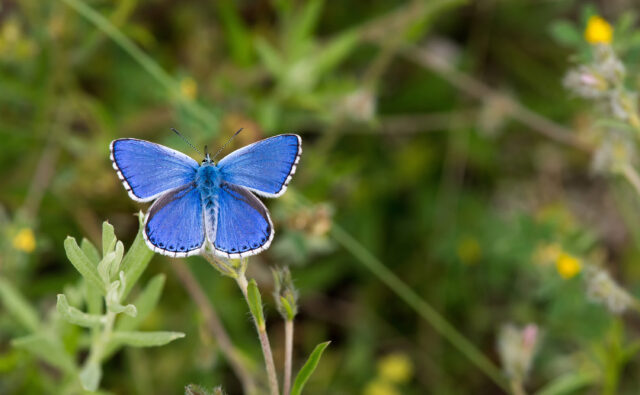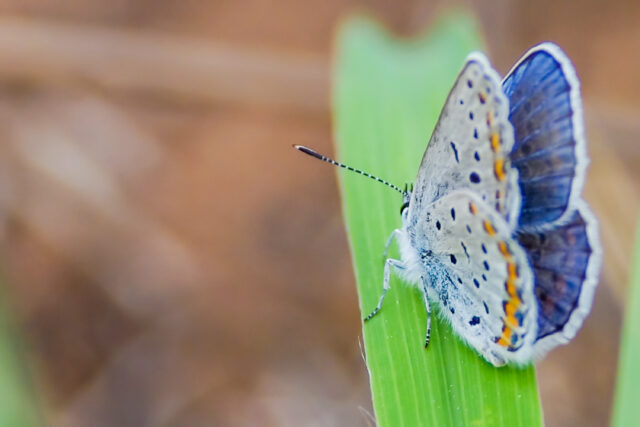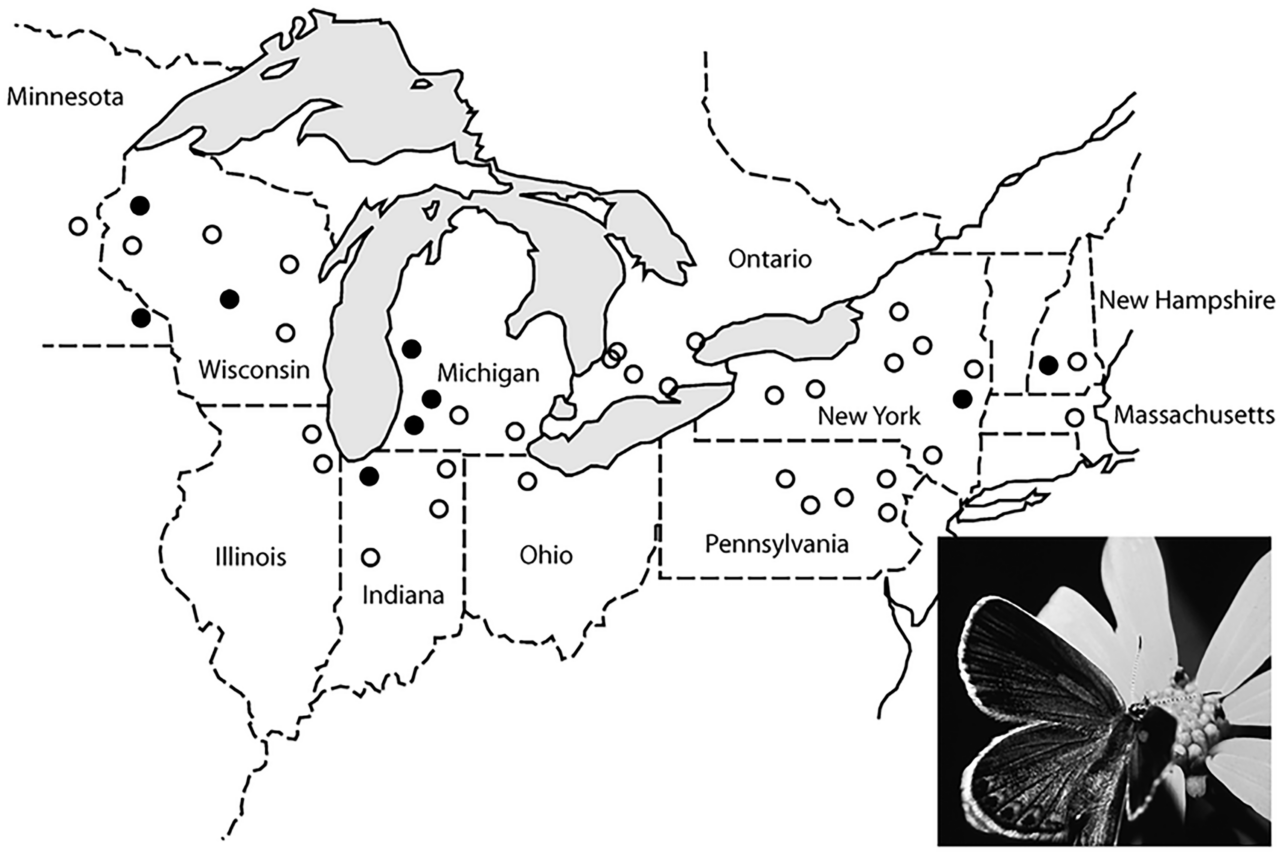The Karner Blue Butterfly: Conservation Efforts and Habitat Protection for an Endangered Species


The beautiful Karner blue butterfly (Lycaeides melissa samuelis) is a small, silvery blue butterfly with a wingspan of about one inch. The butterfly, which is named after the hamlet (Karner, New York) where it was first identified in 1944, lives in oak savannas and pine barren ecosystems extending from Minnesota in the Great Lakes Region eastward to Maine on the Atlantic seaboard.
Historically, the butterfly was found in a continuous band throughout this range, but today it is found in portions of Minnesota, Wisconsin, Michigan, northern Indiana, and New York, and has been reintroduced into Ohio and New Hampshire. Karner blue butterflies do not migrate and seldom travel farther than 700 feet during their short lifetimes. Two generations (broods) of Karner blue butterflies complete their life cycles each year. The second brood of the year survives winter as eggs, aided by an insulating layer of snow.
In New York, the butterfly is currently found in certain parts of the Hudson Valley sand belt, which extends from Albany north to the Glens Falls area. The best places to see Karner blue butterflies are at the Albany Pine Bush and the Saratoga Sandplains.

Northeast United States distribution map of Karner blue butterflies – white circles represent historical occurrences of the butterfly while black circles represent the current distribution. (Map courtesy of the United States Fish & Wildlife Service)
Identifying Characteristics
Males and females differ in their appearance – the topside of the male is silvery or dark blue with narrow black margins; while females are grayish-brown, especially on the outer portions of the wings, with irregular bands of orange crescents inside a narrow black border.
Karner blue adults are nectar-feeders and aid in the pollination of a variety of wildflowers. Karner caterpillars are commonly tended by ants. It appears the ants protect the caterpillars from some natural enemies and in return, the ants collect a nectar from the caterpillar.
A Protected Species
The Karner blue butterfly is a New York State and federally listed endangered species. It was placed on the New York endangered species list in 1977 and on the federal endangered species list in 1992 after it was recognized that the species was in serious decline and in threat of becoming extinct. In some areas, Karner blue butterfly populations have declined by over 90% from their original numbers in the 1970s.
The butterfly is dependent on wild blue lupine (Lupinus perennis) to survive. The caterpillars of the butterfly feed exclusively on the plant leaves of wild blue lupine, which is sometimes referred to as “sundial lupine” because the plant’s leaves can rotate up to 90 degrees to follow the sun. The plant grows in dry, open sandy areas often associated with pitch pine-scrub oak barren habitats, though other areas that represent suitable habitat may include openings in oak woodlands or along rights-of-way with sandy soils. Historically, wildfires and other natural disturbances maintained open areas suitable for wild blue lupine; however, today management practices are used to mimic such disturbances and may include regular mowing and prescribed fire.
The greatest threat to the Karner blue butterfly is the destruction, modification, and fragmentation of their habitat. Because of their reliance on wild blue lupine, which is also a host plant for another rare butterfly (the frosted elfin), the decreasing presence of the plant due to the rapid rise of development and urbanization, suppression of wildfires, and other factors has made it challenging for the butterfly to find suitable habitat. Habitat succession is another threat to this species – as areas eventually grow in and vegetation encroaches, wild blue lupine is shaded out. Climate change is also a threat as warmer temperatures may affect the presence of insulating snowpack, which keeps overwintering eggs dormant and safe from fluctuating temperatures.
Protection and Conservation Efforts
Due to the above-mentioned threats, protective actions are necessary to help increase the Karner blue butterfly population and reduce the chance of species extinction. Research is being conducted to develop methods to enhance or create habitat suitable for the Karner blue butterfly, as well as to establish and propagate wild blue lupine. Management techniques such as mowing, herbicide use, and controlled burning can be utilized to establish or restore appropriate habitat conditions for wild blue lupine and the Karner blue butterfly. Recovery and management plans are key in outlining management techniques used to facilitate the recovery of the Karner blue butterfly.
Protecting habitat from development is also important in preserving this species. Several of the largest populations of Karner blue butterflies in New York are currently protected and managed by the New York Department of Environmental Conservation (NYSDEC) under cooperative agreements with landowners. In New York State, a recovery strategy for the Karner blue butterfly is being developed by a consortium comprised of the United States Fish and Wildlife Services (USFWS); NYSDEC; the New York State Office of Parks, Recreation, and Historic Preservation; The Nature Conservancy; and the Albany Pine Bush Preserve Commission. The partnership’s efforts, along with the involvement of local towns and counties and the support of private landowners, offer hope toward the recovery of the Karner blue butterfly in New York.
References
- Albany Pine Bush Preserve Commission. 2023. Karner Blue. Available from: https://albanypinebush.org/index.php?section=learn-nature-plants-and-animals&cas_cscid=8&casid=32. Accessed February 2023.
- Indiana Dunes National Lakeshore. 2022. Karner Blue Butterfly. Available from: https://esa.npca.org/karner-blue-butterfly/?gclid=EAIaIQobChMIv6TIvMWL_QIVR8GCh3dkQCqEAAYASAAEgIzJ_D_BwE. Accessed February 2023.
- MacDougall, D. 2007. A Field Guide to the Karner Blue Butterfly. ECOS: The Environmental Clearinghouse, Vol. XXXVIII No. 7.
- NYSDEC. 2022. Karner Blue Butterfly. Available from: https://www.dec.ny.gov/animals/7118.html. Accessed February 2023.
- NYNHP. 2022. Online Conservation Guide for Plebejus melissa samuelis. Available from: https://guides.nynhp.org/karner-blue/. Accessed May, 2022.
- USFWS. 2022. Karner Blue Butterfly. Available from: https://www.fws.gov/species/karner-blue butterfly-lycaeides-melissa-samuelis. Accessed February 2023.
- USFWS. 2003. Final Recovery Plan for the Karner Blue Butterfly (Lycaeides melissa samuelis). USFWS, Fort Snelling, Minnesota. 273p.
- USFWS and NYSDEC. 2008. Karner Blue Butterfly (Lycaeides melissa samuelis) Survey Protocols Within the State of New York. 8pp.

About the Author
Meredith Ellis, CE, PWSPermitting & Compliance Manager
Meredith is a Certified Ecologist and Professional Wetland Scientist with 13 years of experience. As a project manager for wetland and regulatory permitting projects, her experience includes conducting wetland delineations, regulatory permitting, environmental monitoring, threatened and endangered species surveys, and ecological habitat assessments. Meredith also has extensive experience with geographic information systems (GIS) for wetland and ecological projects.

About the Author
Anthony PasquiniEnvironmental Scientist
Anthony is an Environmental Scientist responsible for completing a wide variety of environmental compliance and monitoring activities. He has over three years of experience conducting wildlife and ecological surveys across New York. Anthony is currently responsible for completing state and federal wetland permitting, delineating wetlands, habitat and wildlife studies, and consultation.